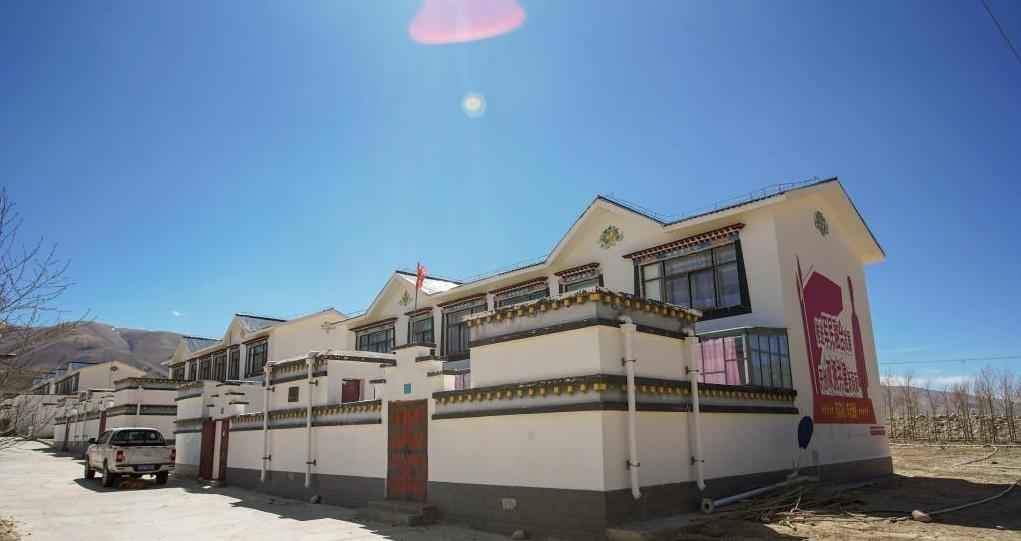five generations of residences of villager in China's Tibet
Xinhua, July 12, 2023 Adjust font size:
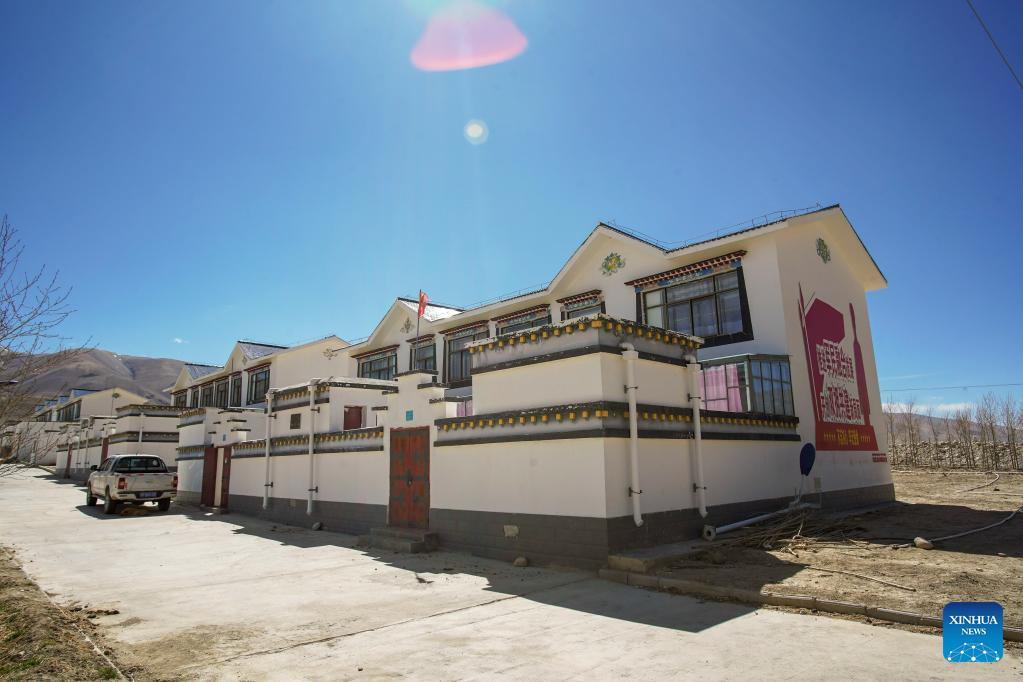
This photo taken on May 28, 2023 shows a view of the "fifth-generation" houses in Demqog Village, Zhaxigang Township, Gar County in Ngari Prefecture of southwest China's Tibet Autonomous Region. Sitting in the sun outside his residence in Demqog Village, Zhaxigang Township, Gar County in Ngari Prefecture of Tibet, 84-year-old Losang Zhamdu told a story of the five homes he had lived in.
"My mother and I lived together in a tent made with yak hair, all our possessions were a goat fur jacket and a worn-out Tibetan blanket," recalled Losang Zhamdu, then a serf, on his childhood, adding, "Was that tent my first home? I don't know, because everything in our hand belonged to the serf owners."
In 1959, democratic reform was launched and feudal serfdom was finally abolished in Tibet. A million serfs and slaves were emancipated, and 20-year-old Losang Zhamdu was one of them.
In the 1960s, with the help of his neighbors, Losang Zhamdu built his second home - a "two-bedroom" flat with stone and mud. Such houses are called "first-generation" ones in Demqog Village.
"This house is not very good. The roof leaked when it rained, and we even didn't have a stove for cooking. But it was much more comfortable if compared to our tent," Losang Zhamdu said of his second home.
In 1990, Demqog was officially established as an administrative village, which came along with "second-generation" houses built with adobe. Through the joint efforts of his family, neighbors and border guards, Losang Zhamdu was able to move in his third home.
In 2006, Losang Zhamdu celebrated the inauguration of his fourth home, also known as the "third-generation" house of Demqog Village - a house with bricks and concrete structure. "It's a comfortable house. I like it very much." Losang Zhamdu said the local government also helped to drill a well next to his home.
In 2010, Shaanxi Province, which had been assisting Ngari, shifted its aids to the construction of new rural areas, and Gar County also kicked off a series projects in Demqog. The village has launched a solar power station for regular electricity service, a village square, a fitness area, a reading room and other supporting facilities. A paved road was also built to connect the outer world.
In 2012, Demqog Village ushered in its fourth-generation houses, two-story buildings of reinforced concrete structure that come with courtyards.
In September 2019, a group of Demqog villagers including the Losang Zhamdu family held a move-in ceremony for their "fifth-generation" houses - two-story, fully functioning buildings each covering a construction area of more than 200 square meters with an exclusive courtyard.
Before the peaceful liberation of Tibet, more than 90 percent of the people had no home of their own, and many serfs even had to live in sheds for livestock, with little clothing and food. By 2020, the per capita housing space of farmers and herdsmen in Tibet had reached 41.46 square meters. (Xinhua/Shao Zedong)
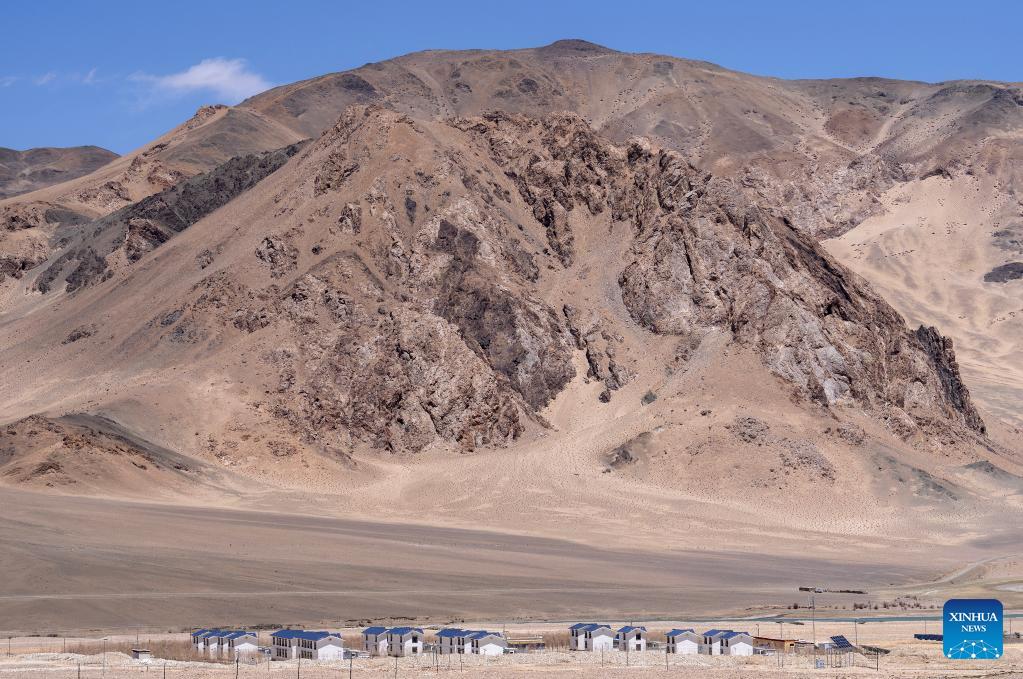
This photo taken on May 28, 2023 shows a view of the "fifth-generation" houses in Demqog Village, Zhaxigang Township, Gar County in Ngari Prefecture of southwest China's Tibet Autonomous Region. Sitting in the sun outside his residence in Demqog Village, Zhaxigang Township, Gar County in Ngari Prefecture of Tibet, 84-year-old Losang Zhamdu told a story of the five homes he had lived in.
"My mother and I lived together in a tent made with yak hair, all our possessions were a goat fur jacket and a worn-out Tibetan blanket," recalled Losang Zhamdu, then a serf, on his childhood, adding, "Was that tent my first home? I don't know, because everything in our hand belonged to the serf owners."
In 1959, democratic reform was launched and feudal serfdom was finally abolished in Tibet. A million serfs and slaves were emancipated, and 20-year-old Losang Zhamdu was one of them.
In the 1960s, with the help of his neighbors, Losang Zhamdu built his second home - a "two-bedroom" flat with stone and mud. Such houses are called "first-generation" ones in Demqog Village.
"This house is not very good. The roof leaked when it rained, and we even didn't have a stove for cooking. But it was much more comfortable if compared to our tent," Losang Zhamdu said of his second home.
In 1990, Demqog was officially established as an administrative village, which came along with "second-generation" houses built with adobe. Through the joint efforts of his family, neighbors and border guards, Losang Zhamdu was able to move in his third home.
In 2006, Losang Zhamdu celebrated the inauguration of his fourth home, also known as the "third-generation" house of Demqog Village - a house with bricks and concrete structure. "It's a comfortable house. I like it very much." Losang Zhamdu said the local government also helped to drill a well next to his home.
In 2010, Shaanxi Province, which had been assisting Ngari, shifted its aids to the construction of new rural areas, and Gar County also kicked off a series projects in Demqog. The village has launched a solar power station for regular electricity service, a village square, a fitness area, a reading room and other supporting facilities. A paved road was also built to connect the outer world.
In 2012, Demqog Village ushered in its fourth-generation houses, two-story buildings of reinforced concrete structure that come with courtyards.
In September 2019, a group of Demqog villagers including the Losang Zhamdu family held a move-in ceremony for their "fifth-generation" houses - two-story, fully functioning buildings each covering a construction area of more than 200 square meters with an exclusive courtyard.
Before the peaceful liberation of Tibet, more than 90 percent of the people had no home of their own, and many serfs even had to live in sheds for livestock, with little clothing and food. By 2020, the per capita housing space of farmers and herdsmen in Tibet had reached 41.46 square meters. (Xinhua/Fei Maohua)
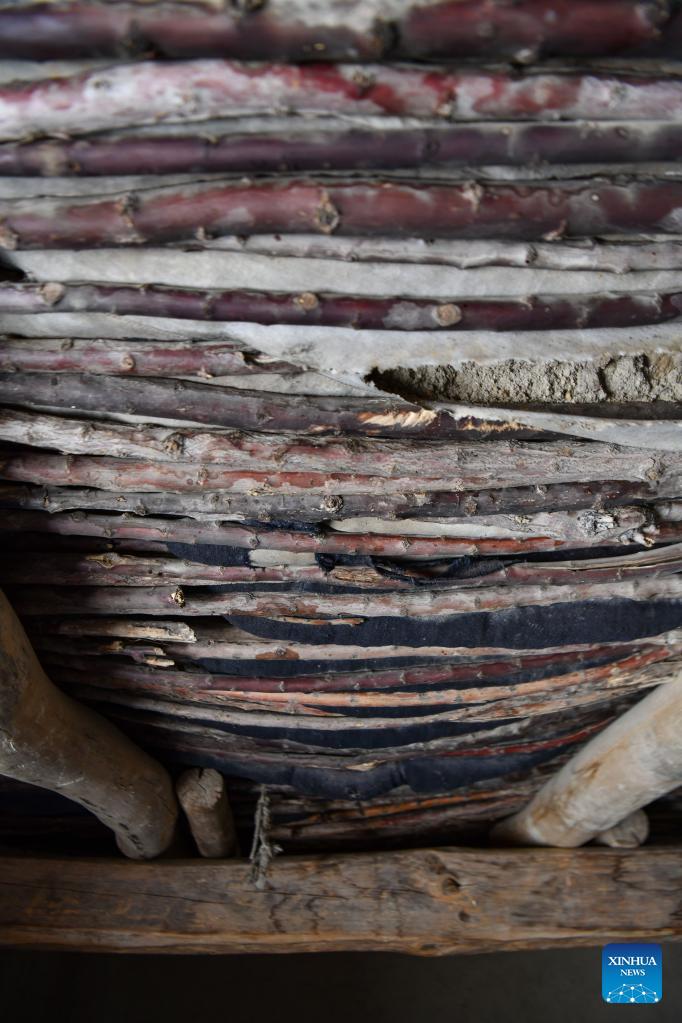
This photo taken on May 28, 2023 shows the roof made with tree branches of an obsolete "second-generation" house in Demqog Village, Zhaxigang Township, Gar County in Ngari Prefecture of southwest China's Tibet Autonomous Region. Sitting in the sun outside his residence in Demqog Village, Zhaxigang Township, Gar County in Ngari Prefecture of Tibet, 84-year-old Losang Zhamdu told a story of the five homes he had lived in.
"My mother and I lived together in a tent made with yak hair, all our possessions were a goat fur jacket and a worn-out Tibetan blanket," recalled Losang Zhamdu, then a serf, on his childhood, adding, "Was that tent my first home? I don't know, because everything in our hand belonged to the serf owners."
In 1959, democratic reform was launched and feudal serfdom was finally abolished in Tibet. A million serfs and slaves were emancipated, and 20-year-old Losang Zhamdu was one of them.
In the 1960s, with the help of his neighbors, Losang Zhamdu built his second home - a "two-bedroom" flat with stone and mud. Such houses are called "first-generation" ones in Demqog Village.
"This house is not very good. The roof leaked when it rained, and we even didn't have a stove for cooking. But it was much more comfortable if compared to our tent," Losang Zhamdu said of his second home.
In 1990, Demqog was officially established as an administrative village, which came along with "second-generation" houses built with adobe. Through the joint efforts of his family, neighbors and border guards, Losang Zhamdu was able to move in his third home.
In 2006, Losang Zhamdu celebrated the inauguration of his fourth home, also known as the "third-generation" house of Demqog Village - a house with bricks and concrete structure. "It's a comfortable house. I like it very much." Losang Zhamdu said the local government also helped to drill a well next to his home.
In 2010, Shaanxi Province, which had been assisting Ngari, shifted its aids to the construction of new rural areas, and Gar County also kicked off a series projects in Demqog. The village has launched a solar power station for regular electricity service, a village square, a fitness area, a reading room and other supporting facilities. A paved road was also built to connect the outer world.
In 2012, Demqog Village ushered in its fourth-generation houses, two-story buildings of reinforced concrete structure that come with courtyards.
In September 2019, a group of Demqog villagers including the Losang Zhamdu family held a move-in ceremony for their "fifth-generation" houses - two-story, fully functioning buildings each covering a construction area of more than 200 square meters with an exclusive courtyard.
Before the peaceful liberation of Tibet, more than 90 percent of the people had no home of their own, and many serfs even had to live in sheds for livestock, with little clothing and food. By 2020, the per capita housing space of farmers and herdsmen in Tibet had reached 41.46 square meters. (Xinhua/Jigme Dorje)
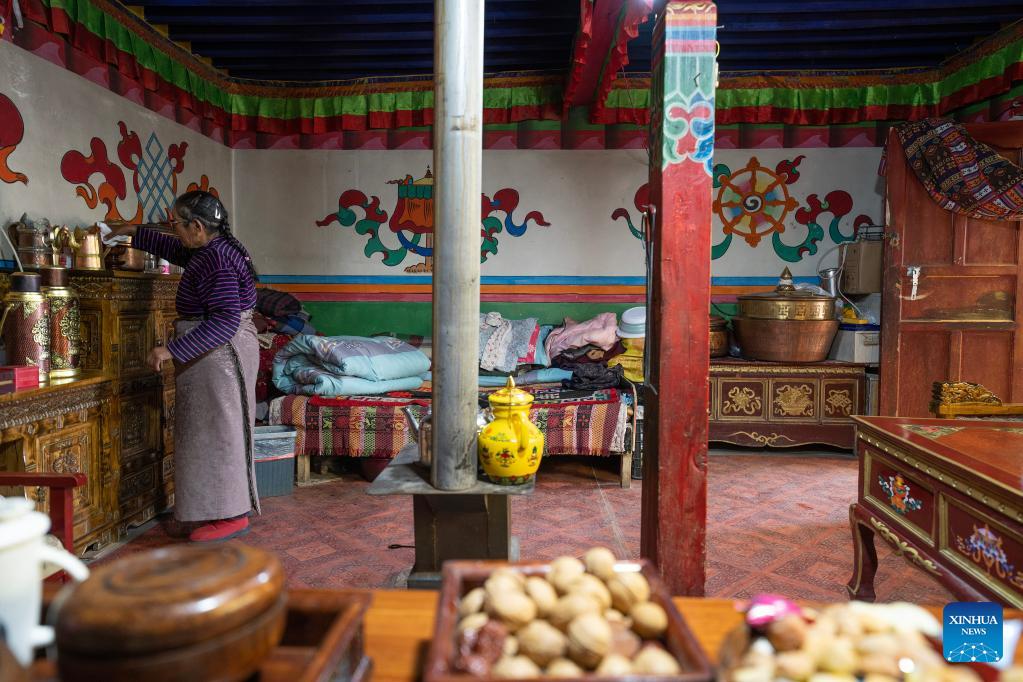
A relative in-law of Losang Zhamdu cleans the living room of her "third-generation" house in Demqog Village, Zhaxigang Township, Gar County in Ngari Prefecture of southwest China's Tibet Autonomous Region, May 28, 2023. Sitting in the sun outside his residence in Demqog Village, Zhaxigang Township, Gar County in Ngari Prefecture of Tibet, 84-year-old Losang Zhamdu told a story of the five homes he had lived in.
"My mother and I lived together in a tent made with yak hair, all our possessions were a goat fur jacket and a worn-out Tibetan blanket," recalled Losang Zhamdu, then a serf, on his childhood, adding, "Was that tent my first home? I don't know, because everything in our hand belonged to the serf owners."
In 1959, democratic reform was launched and feudal serfdom was finally abolished in Tibet. A million serfs and slaves were emancipated, and 20-year-old Losang Zhamdu was one of them.
In the 1960s, with the help of his neighbors, Losang Zhamdu built his second home - a "two-bedroom" flat with stone and mud. Such houses are called "first-generation" ones in Demqog Village.
"This house is not very good. The roof leaked when it rained, and we even didn't have a stove for cooking. But it was much more comfortable if compared to our tent," Losang Zhamdu said of his second home.
In 1990, Demqog was officially established as an administrative village, which came along with "second-generation" houses built with adobe. Through the joint efforts of his family, neighbors and border guards, Losang Zhamdu was able to move in his third home.
In 2006, Losang Zhamdu celebrated the inauguration of his fourth home, also known as the "third-generation" house of Demqog Village - a house with bricks and concrete structure. "It's a comfortable house. I like it very much." Losang Zhamdu said the local government also helped to drill a well next to his home.
In 2010, Shaanxi Province, which had been assisting Ngari, shifted its aids to the construction of new rural areas, and Gar County also kicked off a series projects in Demqog. The village has launched a solar power station for regular electricity service, a village square, a fitness area, a reading room and other supporting facilities. A paved road was also built to connect the outer world.
In 2012, Demqog Village ushered in its fourth-generation houses, two-story buildings of reinforced concrete structure that come with courtyards.
In September 2019, a group of Demqog villagers including the Losang Zhamdu family held a move-in ceremony for their "fifth-generation" houses - two-story, fully functioning buildings each covering a construction area of more than 200 square meters with an exclusive courtyard.
Before the peaceful liberation of Tibet, more than 90 percent of the people had no home of their own, and many serfs even had to live in sheds for livestock, with little clothing and food. By 2020, the per capita housing space of farmers and herdsmen in Tibet had reached 41.46 square meters. (Xinhua/Fei Maohua)
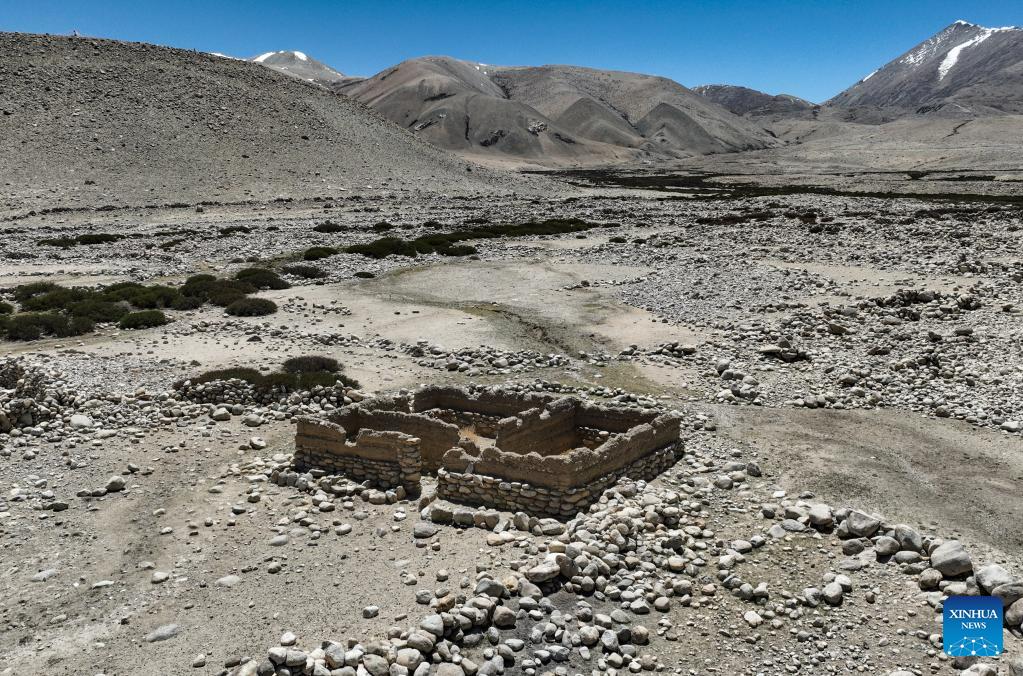
This aerial photo taken on May 28, 2023 shows the remains of a "first-generation" house in Demqog Village, Zhaxigang Township, Gar County in Ngari Prefecture of southwest China's Tibet Autonomous Region. Sitting in the sun outside his residence in Demqog Village, Zhaxigang Township, Gar County in Ngari Prefecture of Tibet, 84-year-old Losang Zhamdu told a story of the five homes he had lived in.
"My mother and I lived together in a tent made with yak hair, all our possessions were a goat fur jacket and a worn-out Tibetan blanket," recalled Losang Zhamdu, then a serf, on his childhood, adding, "Was that tent my first home? I don't know, because everything in our hand belonged to the serf owners."
In 1959, democratic reform was launched and feudal serfdom was finally abolished in Tibet. A million serfs and slaves were emancipated, and 20-year-old Losang Zhamdu was one of them.
In the 1960s, with the help of his neighbors, Losang Zhamdu built his second home - a "two-bedroom" flat with stone and mud. Such houses are called "first-generation" ones in Demqog Village.
"This house is not very good. The roof leaked when it rained, and we even didn't have a stove for cooking. But it was much more comfortable if compared to our tent," Losang Zhamdu said of his second home.
In 1990, Demqog was officially established as an administrative village, which came along with "second-generation" houses built with adobe. Through the joint efforts of his family, neighbors and border guards, Losang Zhamdu was able to move in his third home.
In 2006, Losang Zhamdu celebrated the inauguration of his fourth home, also known as the "third-generation" house of Demqog Village - a house with bricks and concrete structure. "It's a comfortable house. I like it very much." Losang Zhamdu said the local government also helped to drill a well next to his home.
In 2010, Shaanxi Province, which had been assisting Ngari, shifted its aids to the construction of new rural areas, and Gar County also kicked off a series projects in Demqog. The village has launched a solar power station for regular electricity service, a village square, a fitness area, a reading room and other supporting facilities. A paved road was also built to connect the outer world.
In 2012, Demqog Village ushered in its fourth-generation houses, two-story buildings of reinforced concrete structure that come with courtyards.
In September 2019, a group of Demqog villagers including the Losang Zhamdu family held a move-in ceremony for their "fifth-generation" houses - two-story, fully functioning buildings each covering a construction area of more than 200 square meters with an exclusive courtyard.
Before the peaceful liberation of Tibet, more than 90 percent of the people had no home of their own, and many serfs even had to live in sheds for livestock, with little clothing and food. By 2020, the per capita housing space of farmers and herdsmen in Tibet had reached 41.46 square meters. (Xinhua/Jigme Dorje)
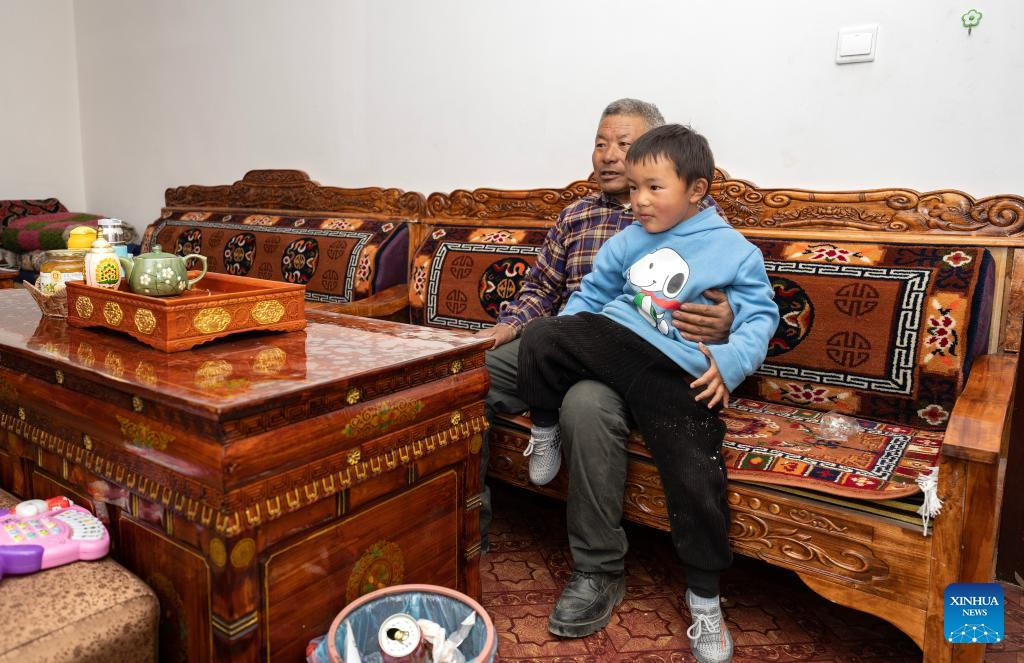
A son and a grandson of Losang Zhamdu watch TV at their "fifth-generation" house in Demqog Village, Zhaxigang Township, Gar County in Ngari Prefecture of southwest China's Tibet Autonomous Region, May 28, 2023. Sitting in the sun outside his residence in Demqog Village, Zhaxigang Township, Gar County in Ngari Prefecture of Tibet, 84-year-old Losang Zhamdu told a story of the five homes he had lived in.
"My mother and I lived together in a tent made with yak hair, all our possessions were a goat fur jacket and a worn-out Tibetan blanket," recalled Losang Zhamdu, then a serf, on his childhood, adding, "Was that tent my first home? I don't know, because everything in our hand belonged to the serf owners."
In 1959, democratic reform was launched and feudal serfdom was finally abolished in Tibet. A million serfs and slaves were emancipated, and 20-year-old Losang Zhamdu was one of them.
In the 1960s, with the help of his neighbors, Losang Zhamdu built his second home - a "two-bedroom" flat with stone and mud. Such houses are called "first-generation" ones in Demqog Village.
"This house is not very good. The roof leaked when it rained, and we even didn't have a stove for cooking. But it was much more comfortable if compared to our tent," Losang Zhamdu said of his second home.
In 1990, Demqog was officially established as an administrative village, which came along with "second-generation" houses built with adobe. Through the joint efforts of his family, neighbors and border guards, Losang Zhamdu was able to move in his third home.
In 2006, Losang Zhamdu celebrated the inauguration of his fourth home, also known as the "third-generation" house of Demqog Village - a house with bricks and concrete structure. "It's a comfortable house. I like it very much." Losang Zhamdu said the local government also helped to drill a well next to his home.
In 2010, Shaanxi Province, which had been assisting Ngari, shifted its aids to the construction of new rural areas, and Gar County also kicked off a series projects in Demqog. The village has launched a solar power station for regular electricity service, a village square, a fitness area, a reading room and other supporting facilities. A paved road was also built to connect the outer world.
In 2012, Demqog Village ushered in its fourth-generation houses, two-story buildings of reinforced concrete structure that come with courtyards.
In September 2019, a group of Demqog villagers including the Losang Zhamdu family held a move-in ceremony for their "fifth-generation" houses - two-story, fully functioning buildings each covering a construction area of more than 200 square meters with an exclusive courtyard.
Before the peaceful liberation of Tibet, more than 90 percent of the people had no home of their own, and many serfs even had to live in sheds for livestock, with little clothing and food. By 2020, the per capita housing space of farmers and herdsmen in Tibet had reached 41.46 square meters. (Xinhua/Fei Maohua)

This aerial photo taken on May 28, 2023 shows a "third-generation" house in Demqog Village, Zhaxigang Township, Gar County in Ngari Prefecture of southwest China's Tibet Autonomous Region. Sitting in the sun outside his residence in Demqog Village, Zhaxigang Township, Gar County in Ngari Prefecture of Tibet, 84-year-old Losang Zhamdu told a story of the five homes he had lived in.
"My mother and I lived together in a tent made with yak hair, all our possessions were a goat fur jacket and a worn-out Tibetan blanket," recalled Losang Zhamdu, then a serf, on his childhood, adding, "Was that tent my first home? I don't know, because everything in our hand belonged to the serf owners."
In 1959, democratic reform was launched and feudal serfdom was finally abolished in Tibet. A million serfs and slaves were emancipated, and 20-year-old Losang Zhamdu was one of them.
In the 1960s, with the help of his neighbors, Losang Zhamdu built his second home - a "two-bedroom" flat with stone and mud. Such houses are called "first-generation" ones in Demqog Village.
"This house is not very good. The roof leaked when it rained, and we even didn't have a stove for cooking. But it was much more comfortable if compared to our tent," Losang Zhamdu said of his second home.
In 1990, Demqog was officially established as an administrative village, which came along with "second-generation" houses built with adobe. Through the joint efforts of his family, neighbors and border guards, Losang Zhamdu was able to move in his third home.
In 2006, Losang Zhamdu celebrated the inauguration of his fourth home, also known as the "third-generation" house of Demqog Village - a house with bricks and concrete structure. "It's a comfortable house. I like it very much." Losang Zhamdu said the local government also helped to drill a well next to his home.
In 2010, Shaanxi Province, which had been assisting Ngari, shifted its aids to the construction of new rural areas, and Gar County also kicked off a series projects in Demqog. The village has launched a solar power station for regular electricity service, a village square, a fitness area, a reading room and other supporting facilities. A paved road was also built to connect the outer world.
In 2012, Demqog Village ushered in its fourth-generation houses, two-story buildings of reinforced concrete structure that come with courtyards.
In September 2019, a group of Demqog villagers including the Losang Zhamdu family held a move-in ceremony for their "fifth-generation" houses - two-story, fully functioning buildings each covering a construction area of more than 200 square meters with an exclusive courtyard.
Before the peaceful liberation of Tibet, more than 90 percent of the people had no home of their own, and many serfs even had to live in sheds for livestock, with little clothing and food. By 2020, the per capita housing space of farmers and herdsmen in Tibet had reached 41.46 square meters. (Xinhua/Jigme Dorje)

A grand daughter-in law-of Losang Zhamdu, looks out of the window of her "fifth-generation" house in Demqog Village, Zhaxigang Township, Gar County in Ngari Prefecture of southwest China's Tibet Autonomous Region, May 28, 2023. Sitting in the sun outside his residence in Demqog Village, Zhaxigang Township, Gar County in Ngari Prefecture of Tibet, 84-year-old Losang Zhamdu told a story of the five homes he had lived in.
"My mother and I lived together in a tent made with yak hair, all our possessions were a goat fur jacket and a worn-out Tibetan blanket," recalled Losang Zhamdu, then a serf, on his childhood, adding, "Was that tent my first home? I don't know, because everything in our hand belonged to the serf owners."
In 1959, democratic reform was launched and feudal serfdom was finally abolished in Tibet. A million serfs and slaves were emancipated, and 20-year-old Losang Zhamdu was one of them.
In the 1960s, with the help of his neighbors, Losang Zhamdu built his second home - a "two-bedroom" flat with stone and mud. Such houses are called "first-generation" ones in Demqog Village.
"This house is not very good. The roof leaked when it rained, and we even didn't have a stove for cooking. But it was much more comfortable if compared to our tent," Losang Zhamdu said of his second home.
In 1990, Demqog was officially established as an administrative village, which came along with "second-generation" houses built with adobe. Through the joint efforts of his family, neighbors and border guards, Losang Zhamdu was able to move in his third home.
In 2006, Losang Zhamdu celebrated the inauguration of his fourth home, also known as the "third-generation" house of Demqog Village - a house with bricks and concrete structure. "It's a comfortable house. I like it very much." Losang Zhamdu said the local government also helped to drill a well next to his home.
In 2010, Shaanxi Province, which had been assisting Ngari, shifted its aids to the construction of new rural areas, and Gar County also kicked off a series projects in Demqog. The village has launched a solar power station for regular electricity service, a village square, a fitness area, a reading room and other supporting facilities. A paved road was also built to connect the outer world.
In 2012, Demqog Village ushered in its fourth-generation houses, two-story buildings of reinforced concrete structure that come with courtyards.
In September 2019, a group of Demqog villagers including the Losang Zhamdu family held a move-in ceremony for their "fifth-generation" houses - two-story, fully functioning buildings each covering a construction area of more than 200 square meters with an exclusive courtyard.
Before the peaceful liberation of Tibet, more than 90 percent of the people had no home of their own, and many serfs even had to live in sheds for livestock, with little clothing and food. By 2020, the per capita housing space of farmers and herdsmen in Tibet had reached 41.46 square meters. (Xinhua/Fei Maohua)
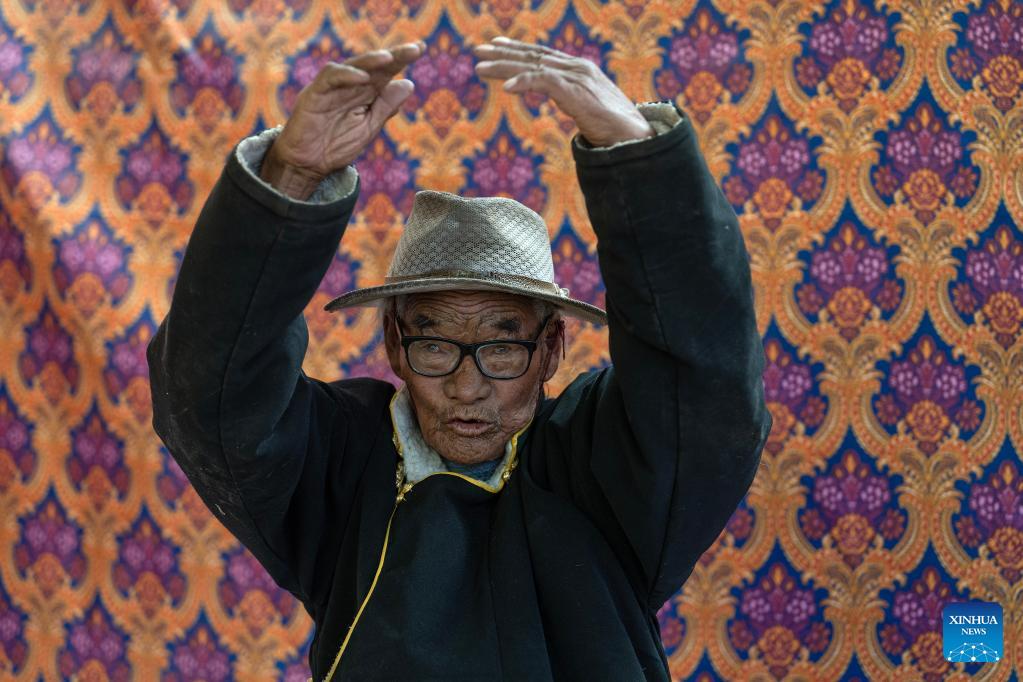
Losang Zhamdu tells the story of his life at his fourth residence, or one of the "third-generation" houses, in Demqog Village, Zhaxigang Township, Gar County in Ngari Prefecture of southwest China's Tibet Autonomous Region, May 28, 2023. Sitting in the sun outside his residence in Demqog Village, Zhaxigang Township, Gar County in Ngari Prefecture of Tibet, 84-year-old Losang Zhamdu told a story of the five homes he had lived in.
"My mother and I lived together in a tent made with yak hair, all our possessions were a goat fur jacket and a worn-out Tibetan blanket," recalled Losang Zhamdu, then a serf, on his childhood, adding, "Was that tent my first home? I don't know, because everything in our hand belonged to the serf owners."
In 1959, democratic reform was launched and feudal serfdom was finally abolished in Tibet. A million serfs and slaves were emancipated, and 20-year-old Losang Zhamdu was one of them.
In the 1960s, with the help of his neighbors, Losang Zhamdu built his second home - a "two-bedroom" flat with stone and mud. Such houses are called "first-generation" ones in Demqog Village.
"This house is not very good. The roof leaked when it rained, and we even didn't have a stove for cooking. But it was much more comfortable if compared to our tent," Losang Zhamdu said of his second home.
In 1990, Demqog was officially established as an administrative village, which came along with "second-generation" houses built with adobe. Through the joint efforts of his family, neighbors and border guards, Losang Zhamdu was able to move in his third home.
In 2006, Losang Zhamdu celebrated the inauguration of his fourth home, also known as the "third-generation" house of Demqog Village - a house with bricks and concrete structure. "It's a comfortable house. I like it very much." Losang Zhamdu said the local government also helped to drill a well next to his home.
In 2010, Shaanxi Province, which had been assisting Ngari, shifted its aids to the construction of new rural areas, and Gar County also kicked off a series projects in Demqog. The village has launched a solar power station for regular electricity service, a village square, a fitness area, a reading room and other supporting facilities. A paved road was also built to connect the outer world.
In 2012, Demqog Village ushered in its fourth-generation houses, two-story buildings of reinforced concrete structure that come with courtyards.
In September 2019, a group of Demqog villagers including the Losang Zhamdu family held a move-in ceremony for their "fifth-generation" houses - two-story, fully functioning buildings each covering a construction area of more than 200 square meters with an exclusive courtyard.
Before the peaceful liberation of Tibet, more than 90 percent of the people had no home of their own, and many serfs even had to live in sheds for livestock, with little clothing and food. By 2020, the per capita housing space of farmers and herdsmen in Tibet had reached 41.46 square meters. (Xinhua/Fei Maohua)
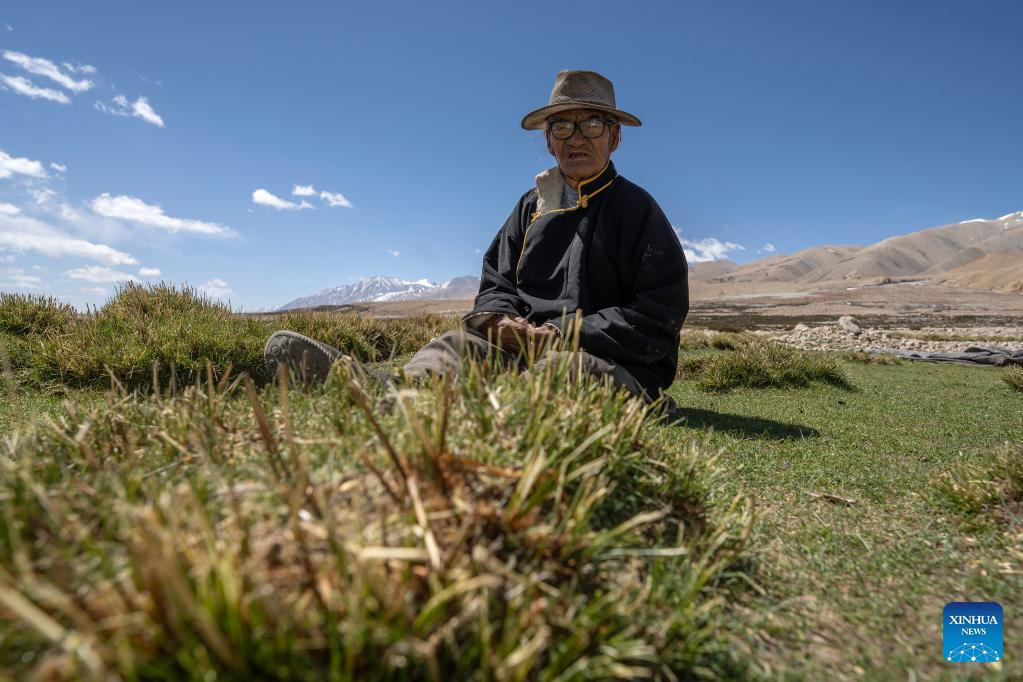
Losang Zhamdu basks at a meadow in front of his residence in Demqog Village, Zhaxigang Township, Gar County in Ngari Prefecture of southwest China's Tibet Autonomous Region, May 28, 2023. Sitting in the sun outside his residence in Demqog Village, Zhaxigang Township, Gar County in Ngari Prefecture of Tibet, 84-year-old Losang Zhamdu told a story of the five homes he had lived in.
"My mother and I lived together in a tent made with yak hair, all our possessions were a goat fur jacket and a worn-out Tibetan blanket," recalled Losang Zhamdu, then a serf, on his childhood, adding, "Was that tent my first home? I don't know, because everything in our hand belonged to the serf owners."
In 1959, democratic reform was launched and feudal serfdom was finally abolished in Tibet. A million serfs and slaves were emancipated, and 20-year-old Losang Zhamdu was one of them.
In the 1960s, with the help of his neighbors, Losang Zhamdu built his second home - a "two-bedroom" flat with stone and mud. Such houses are called "first-generation" ones in Demqog Village.
"This house is not very good. The roof leaked when it rained, and we even didn't have a stove for cooking. But it was much more comfortable if compared to our tent," Losang Zhamdu said of his second home.
In 1990, Demqog was officially established as an administrative village, which came along with "second-generation" houses built with adobe. Through the joint efforts of his family, neighbors and border guards, Losang Zhamdu was able to move in his third home.
In 2006, Losang Zhamdu celebrated the inauguration of his fourth home, also known as the "third-generation" house of Demqog Village - a house with bricks and concrete structure. "It's a comfortable house. I like it very much." Losang Zhamdu said the local government also helped to drill a well next to his home.
In 2010, Shaanxi Province, which had been assisting Ngari, shifted its aids to the construction of new rural areas, and Gar County also kicked off a series projects in Demqog. The village has launched a solar power station for regular electricity service, a village square, a fitness area, a reading room and other supporting facilities. A paved road was also built to connect the outer world.
In 2012, Demqog Village ushered in its fourth-generation houses, two-story buildings of reinforced concrete structure that come with courtyards.
In September 2019, a group of Demqog villagers including the Losang Zhamdu family held a move-in ceremony for their "fifth-generation" houses - two-story, fully functioning buildings each covering a construction area of more than 200 square meters with an exclusive courtyard.
Before the peaceful liberation of Tibet, more than 90 percent of the people had no home of their own, and many serfs even had to live in sheds for livestock, with little clothing and food. By 2020, the per capita housing space of farmers and herdsmen in Tibet had reached 41.46 square meters. (Xinhua/Fei Maohua)
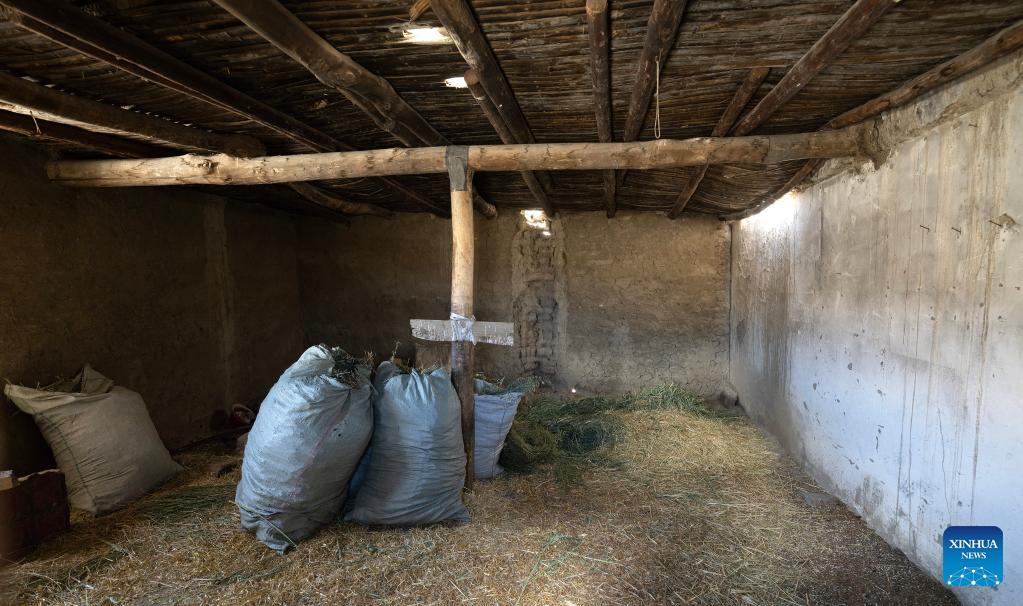
This photo taken on May 28, 2023 shows an interior view of an obsolete "second-generation" house in Demqog Village, Zhaxigang Township, Gar County in Ngari Prefecture of southwest China's Tibet Autonomous Region. Sitting in the sun outside his residence in Demqog Village, Zhaxigang Township, Gar County in Ngari Prefecture of Tibet, 84-year-old Losang Zhamdu told a story of the five homes he had lived in.
"My mother and I lived together in a tent made with yak hair, all our possessions were a goat fur jacket and a worn-out Tibetan blanket," recalled Losang Zhamdu, then a serf, on his childhood, adding, "Was that tent my first home? I don't know, because everything in our hand belonged to the serf owners."
In 1959, democratic reform was launched and feudal serfdom was finally abolished in Tibet. A million serfs and slaves were emancipated, and 20-year-old Losang Zhamdu was one of them.
In the 1960s, with the help of his neighbors, Losang Zhamdu built his second home - a "two-bedroom" flat with stone and mud. Such houses are called "first-generation" ones in Demqog Village.
"This house is not very good. The roof leaked when it rained, and we even didn't have a stove for cooking. But it was much more comfortable if compared to our tent," Losang Zhamdu said of his second home.
In 1990, Demqog was officially established as an administrative village, which came along with "second-generation" houses built with adobe. Through the joint efforts of his family, neighbors and border guards, Losang Zhamdu was able to move in his third home.
In 2006, Losang Zhamdu celebrated the inauguration of his fourth home, also known as the "third-generation" house of Demqog Village - a house with bricks and concrete structure. "It's a comfortable house. I like it very much." Losang Zhamdu said the local government also helped to drill a well next to his home.
In 2010, Shaanxi Province, which had been assisting Ngari, shifted its aids to the construction of new rural areas, and Gar County also kicked off a series projects in Demqog. The village has launched a solar power station for regular electricity service, a village square, a fitness area, a reading room and other supporting facilities. A paved road was also built to connect the outer world.
In 2012, Demqog Village ushered in its fourth-generation houses, two-story buildings of reinforced concrete structure that come with courtyards.
In September 2019, a group of Demqog villagers including the Losang Zhamdu family held a move-in ceremony for their "fifth-generation" houses - two-story, fully functioning buildings each covering a construction area of more than 200 square meters with an exclusive courtyard.
Before the peaceful liberation of Tibet, more than 90 percent of the people had no home of their own, and many serfs even had to live in sheds for livestock, with little clothing and food. By 2020, the per capita housing space of farmers and herdsmen in Tibet had reached 41.46 square meters. (Xinhua/Fei Maohua)
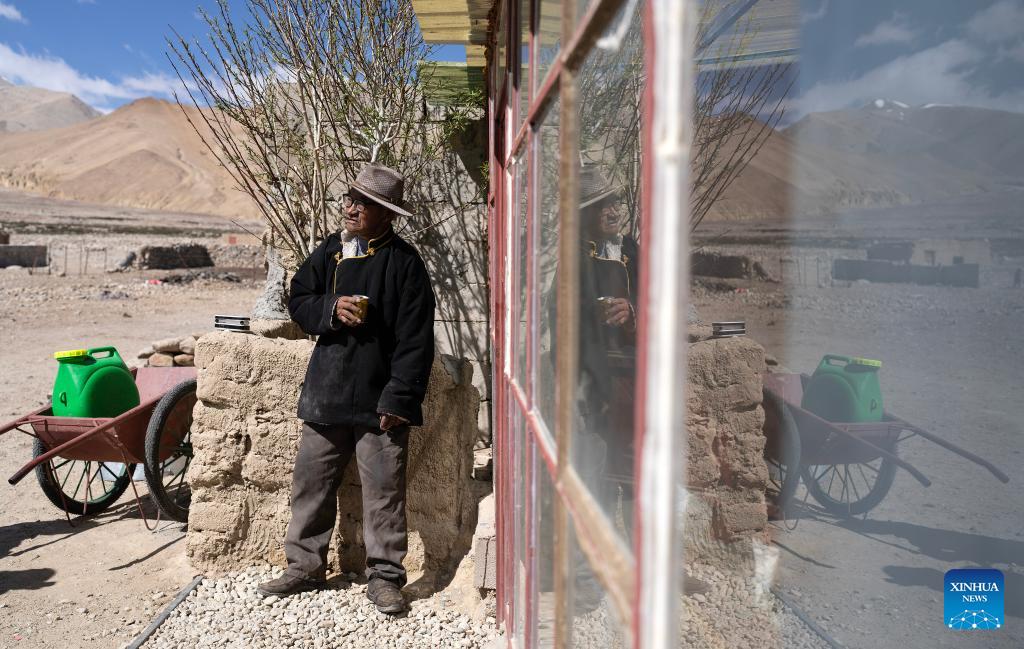
Losang Zhamdu is pictured in front of his fourth residence, or one of the "third-generation" houses, in Demqog Village, Zhaxigang Township, Gar County in Ngari Prefecture of southwest China's Tibet Autonomous Region, May 28, 2023. Sitting in the sun outside his residence in Demqog Village, Zhaxigang Township, Gar County in Ngari Prefecture of Tibet, 84-year-old Losang Zhamdu told a story of the five homes he had lived in.
"My mother and I lived together in a tent made with yak hair, all our possessions were a goat fur jacket and a worn-out Tibetan blanket," recalled Losang Zhamdu, then a serf, on his childhood, adding, "Was that tent my first home? I don't know, because everything in our hand belonged to the serf owners."
In 1959, democratic reform was launched and feudal serfdom was finally abolished in Tibet. A million serfs and slaves were emancipated, and 20-year-old Losang Zhamdu was one of them.
In the 1960s, with the help of his neighbors, Losang Zhamdu built his second home - a "two-bedroom" flat with stone and mud. Such houses are called "first-generation" ones in Demqog Village.
"This house is not very good. The roof leaked when it rained, and we even didn't have a stove for cooking. But it was much more comfortable if compared to our tent," Losang Zhamdu said of his second home.
In 1990, Demqog was officially established as an administrative village, which came along with "second-generation" houses built with adobe. Through the joint efforts of his family, neighbors and border guards, Losang Zhamdu was able to move in his third home.
In 2006, Losang Zhamdu celebrated the inauguration of his fourth home, also known as the "third-generation" house of Demqog Village - a house with bricks and concrete structure. "It's a comfortable house. I like it very much." Losang Zhamdu said the local government also helped to drill a well next to his home.
In 2010, Shaanxi Province, which had been assisting Ngari, shifted its aids to the construction of new rural areas, and Gar County also kicked off a series projects in Demqog. The village has launched a solar power station for regular electricity service, a village square, a fitness area, a reading room and other supporting facilities. A paved road was also built to connect the outer world.
In 2012, Demqog Village ushered in its fourth-generation houses, two-story buildings of reinforced concrete structure that come with courtyards.
In September 2019, a group of Demqog villagers including the Losang Zhamdu family held a move-in ceremony for their "fifth-generation" houses - two-story, fully functioning buildings each covering a construction area of more than 200 square meters with an exclusive courtyard.
Before the peaceful liberation of Tibet, more than 90 percent of the people had no home of their own, and many serfs even had to live in sheds for livestock, with little clothing and food. By 2020, the per capita housing space of farmers and herdsmen in Tibet had reached 41.46 square meters. (Xinhua/Fei Maohua)
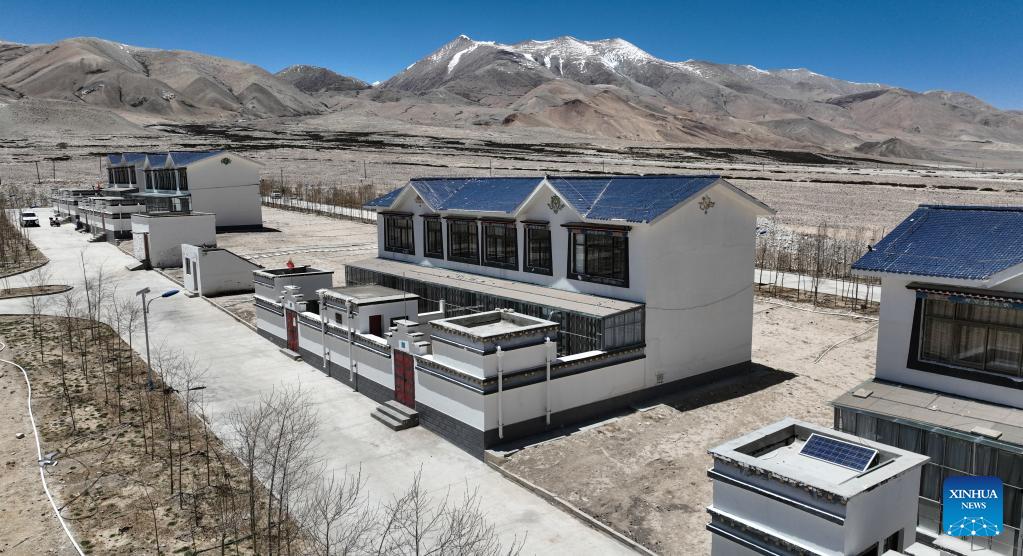
This aerial photo taken on May 28, 2023 shows a view of the "fifth-generation" houses in Demqog Village, Zhaxigang Township, Gar County in Ngari Prefecture of southwest China's Tibet Autonomous Region. Sitting in the sun outside his residence in Demqog Village, Zhaxigang Township, Gar County in Ngari Prefecture of Tibet, 84-year-old Losang Zhamdu told a story of the five homes he had lived in.
"My mother and I lived together in a tent made with yak hair, all our possessions were a goat fur jacket and a worn-out Tibetan blanket," recalled Losang Zhamdu, then a serf, on his childhood, adding, "Was that tent my first home? I don't know, because everything in our hand belonged to the serf owners."
In 1959, democratic reform was launched and feudal serfdom was finally abolished in Tibet. A million serfs and slaves were emancipated, and 20-year-old Losang Zhamdu was one of them.
In the 1960s, with the help of his neighbors, Losang Zhamdu built his second home - a "two-bedroom" flat with stone and mud. Such houses are called "first-generation" ones in Demqog Village.
"This house is not very good. The roof leaked when it rained, and we even didn't have a stove for cooking. But it was much more comfortable if compared to our tent," Losang Zhamdu said of his second home.
In 1990, Demqog was officially established as an administrative village, which came along with "second-generation" houses built with adobe. Through the joint efforts of his family, neighbors and border guards, Losang Zhamdu was able to move in his third home.
In 2006, Losang Zhamdu celebrated the inauguration of his fourth home, also known as the "third-generation" house of Demqog Village - a house with bricks and concrete structure. "It's a comfortable house. I like it very much." Losang Zhamdu said the local government also helped to drill a well next to his home.
In 2010, Shaanxi Province, which had been assisting Ngari, shifted its aids to the construction of new rural areas, and Gar County also kicked off a series projects in Demqog. The village has launched a solar power station for regular electricity service, a village square, a fitness area, a reading room and other supporting facilities. A paved road was also built to connect the outer world.
In 2012, Demqog Village ushered in its fourth-generation houses, two-story buildings of reinforced concrete structure that come with courtyards.
In September 2019, a group of Demqog villagers including the Losang Zhamdu family held a move-in ceremony for their "fifth-generation" houses - two-story, fully functioning buildings each covering a construction area of more than 200 square meters with an exclusive courtyard.
Before the peaceful liberation of Tibet, more than 90 percent of the people had no home of their own, and many serfs even had to live in sheds for livestock, with little clothing and food. By 2020, the per capita housing space of farmers and herdsmen in Tibet had reached 41.46 square meters. (Xinhua/Jigme Dorje)
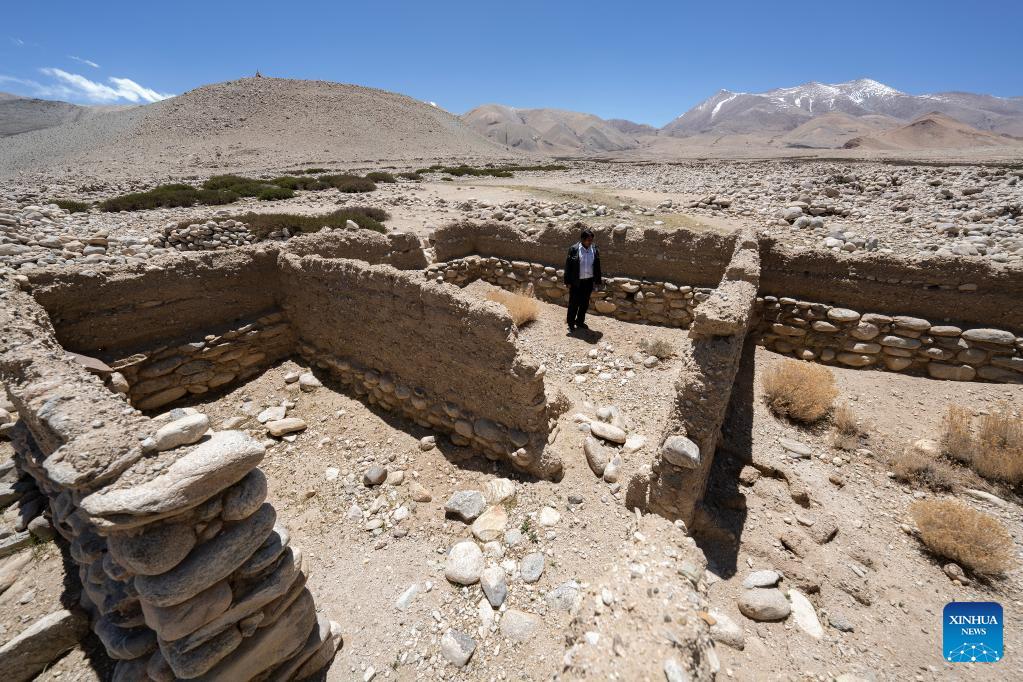
Sonam Cering, deputy head of Zhaxigang Township, shows the remains of a "first-generation" house in Demqog Village, Zhaxigang Township, Gar County in Ngari Prefecture of southwest China's Tibet Autonomous Region, May 28, 2023. Sitting in the sun outside his residence in Demqog Village, Zhaxigang Township, Gar County in Ngari Prefecture of Tibet, 84-year-old Losang Zhamdu told a story of the five homes he had lived in.
"My mother and I lived together in a tent made with yak hair, all our possessions were a goat fur jacket and a worn-out Tibetan blanket," recalled Losang Zhamdu, then a serf, on his childhood, adding, "Was that tent my first home? I don't know, because everything in our hand belonged to the serf owners."
In 1959, democratic reform was launched and feudal serfdom was finally abolished in Tibet. A million serfs and slaves were emancipated, and 20-year-old Losang Zhamdu was one of them.
In the 1960s, with the help of his neighbors, Losang Zhamdu built his second home - a "two-bedroom" flat with stone and mud. Such houses are called "first-generation" ones in Demqog Village.
"This house is not very good. The roof leaked when it rained, and we even didn't have a stove for cooking. But it was much more comfortable if compared to our tent," Losang Zhamdu said of his second home.
In 1990, Demqog was officially established as an administrative village, which came along with "second-generation" houses built with adobe. Through the joint efforts of his family, neighbors and border guards, Losang Zhamdu was able to move in his third home.
In 2006, Losang Zhamdu celebrated the inauguration of his fourth home, also known as the "third-generation" house of Demqog Village - a house with bricks and concrete structure. "It's a comfortable house. I like it very much." Losang Zhamdu said the local government also helped to drill a well next to his home.
In 2010, Shaanxi Province, which had been assisting Ngari, shifted its aids to the construction of new rural areas, and Gar County also kicked off a series projects in Demqog. The village has launched a solar power station for regular electricity service, a village square, a fitness area, a reading room and other supporting facilities. A paved road was also built to connect the outer world.
In 2012, Demqog Village ushered in its fourth-generation houses, two-story buildings of reinforced concrete structure that come with courtyards.
In September 2019, a group of Demqog villagers including the Losang Zhamdu family held a move-in ceremony for their "fifth-generation" houses - two-story, fully functioning buildings each covering a construction area of more than 200 square meters with an exclusive courtyard.
Before the peaceful liberation of Tibet, more than 90 percent of the people had no home of their own, and many serfs even had to live in sheds for livestock, with little clothing and food. By 2020, the per capita housing space of farmers and herdsmen in Tibet had reached 41.46 square meters. (Xinhua/Fei Maohua)
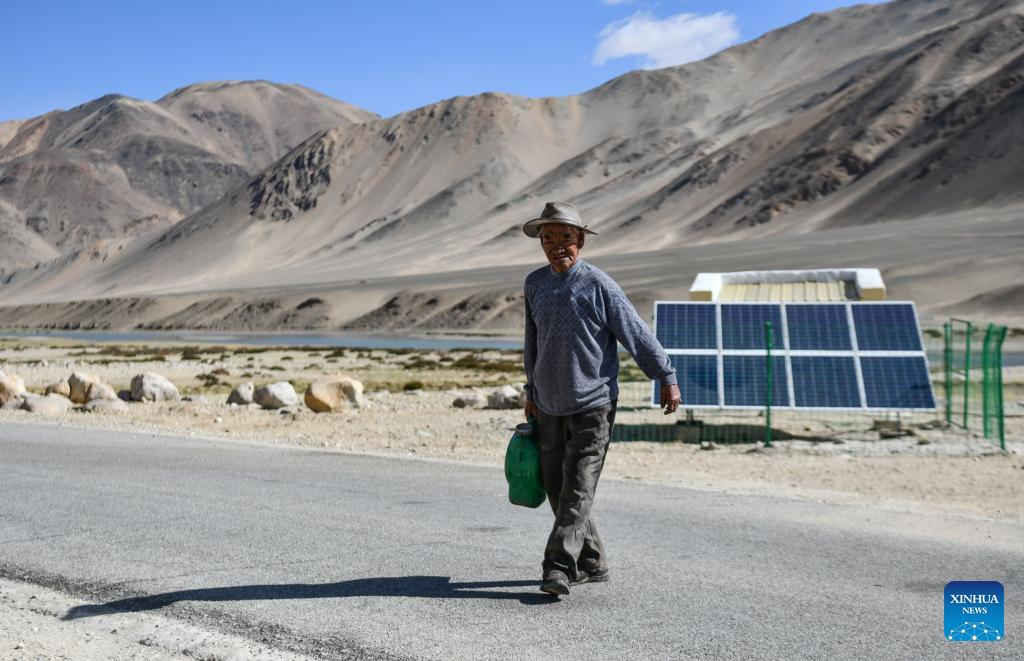
Losang Zhamdu fetches water from the well near his "third-generation" house in Demqog Village, Zhaxigang Township, Gar County in Ngari Prefecture of southwest China's Tibet Autonomous Region, May 28, 2023. Sitting in the sun outside his residence in Demqog Village, Zhaxigang Township, Gar County in Ngari Prefecture of Tibet, 84-year-old Losang Zhamdu told a story of the five homes he had lived in.
"My mother and I lived together in a tent made with yak hair, all our possessions were a goat fur jacket and a worn-out Tibetan blanket," recalled Losang Zhamdu, then a serf, on his childhood, adding, "Was that tent my first home? I don't know, because everything in our hand belonged to the serf owners."
In 1959, democratic reform was launched and feudal serfdom was finally abolished in Tibet. A million serfs and slaves were emancipated, and 20-year-old Losang Zhamdu was one of them.
In the 1960s, with the help of his neighbors, Losang Zhamdu built his second home - a "two-bedroom" flat with stone and mud. Such houses are called "first-generation" ones in Demqog Village.
"This house is not very good. The roof leaked when it rained, and we even didn't have a stove for cooking. But it was much more comfortable if compared to our tent," Losang Zhamdu said of his second home.
In 1990, Demqog was officially established as an administrative village, which came along with "second-generation" houses built with adobe. Through the joint efforts of his family, neighbors and border guards, Losang Zhamdu was able to move in his third home.
In 2006, Losang Zhamdu celebrated the inauguration of his fourth home, also known as the "third-generation" house of Demqog Village - a house with bricks and concrete structure. "It's a comfortable house. I like it very much." Losang Zhamdu said the local government also helped to drill a well next to his home.
In 2010, Shaanxi Province, which had been assisting Ngari, shifted its aids to the construction of new rural areas, and Gar County also kicked off a series projects in Demqog. The village has launched a solar power station for regular electricity service, a village square, a fitness area, a reading room and other supporting facilities. A paved road was also built to connect the outer world.
In 2012, Demqog Village ushered in its fourth-generation houses, two-story buildings of reinforced concrete structure that come with courtyards.
In September 2019, a group of Demqog villagers including the Losang Zhamdu family held a move-in ceremony for their "fifth-generation" houses - two-story, fully functioning buildings each covering a construction area of more than 200 square meters with an exclusive courtyard.
Before the peaceful liberation of Tibet, more than 90 percent of the people had no home of their own, and many serfs even had to live in sheds for livestock, with little clothing and food. By 2020, the per capita housing space of farmers and herdsmen in Tibet had reached 41.46 square meters. (Xinhua/Jigme Dorje)
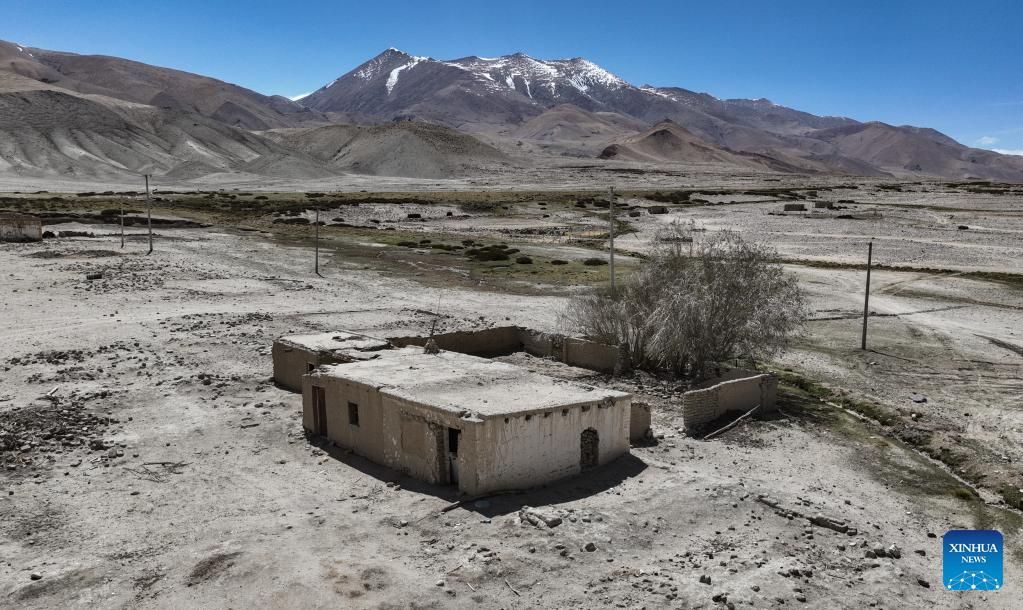
This aerial photo taken on May 28, 2023 shows a "second-generation" house in Demqog Village, Zhaxigang Township, Gar County in Ngari Prefecture of southwest China's Tibet Autonomous Region. Sitting in the sun outside his residence in Demqog Village, Zhaxigang Township, Gar County in Ngari Prefecture of Tibet, 84-year-old Losang Zhamdu told a story of the five homes he had lived in.
"My mother and I lived together in a tent made with yak hair, all our possessions were a goat fur jacket and a worn-out Tibetan blanket," recalled Losang Zhamdu, then a serf, on his childhood, adding, "Was that tent my first home? I don't know, because everything in our hand belonged to the serf owners."
In 1959, democratic reform was launched and feudal serfdom was finally abolished in Tibet. A million serfs and slaves were emancipated, and 20-year-old Losang Zhamdu was one of them.
In the 1960s, with the help of his neighbors, Losang Zhamdu built his second home - a "two-bedroom" flat with stone and mud. Such houses are called "first-generation" ones in Demqog Village.
"This house is not very good. The roof leaked when it rained, and we even didn't have a stove for cooking. But it was much more comfortable if compared to our tent," Losang Zhamdu said of his second home.
In 1990, Demqog was officially established as an administrative village, which came along with "second-generation" houses built with adobe. Through the joint efforts of his family, neighbors and border guards, Losang Zhamdu was able to move in his third home.
In 2006, Losang Zhamdu celebrated the inauguration of his fourth home, also known as the "third-generation" house of Demqog Village - a house with bricks and concrete structure. "It's a comfortable house. I like it very much." Losang Zhamdu said the local government also helped to drill a well next to his home.
In 2010, Shaanxi Province, which had been assisting Ngari, shifted its aids to the construction of new rural areas, and Gar County also kicked off a series projects in Demqog. The village has launched a solar power station for regular electricity service, a village square, a fitness area, a reading room and other supporting facilities. A paved road was also built to connect the outer world.
In 2012, Demqog Village ushered in its fourth-generation houses, two-story buildings of reinforced concrete structure that come with courtyards.
In September 2019, a group of Demqog villagers including the Losang Zhamdu family held a move-in ceremony for their "fifth-generation" houses - two-story, fully functioning buildings each covering a construction area of more than 200 square meters with an exclusive courtyard.
Before the peaceful liberation of Tibet, more than 90 percent of the people had no home of their own, and many serfs even had to live in sheds for livestock, with little clothing and food. By 2020, the per capita housing space of farmers and herdsmen in Tibet had reached 41.46 square meters. (Xinhua/Jigme Dorje)
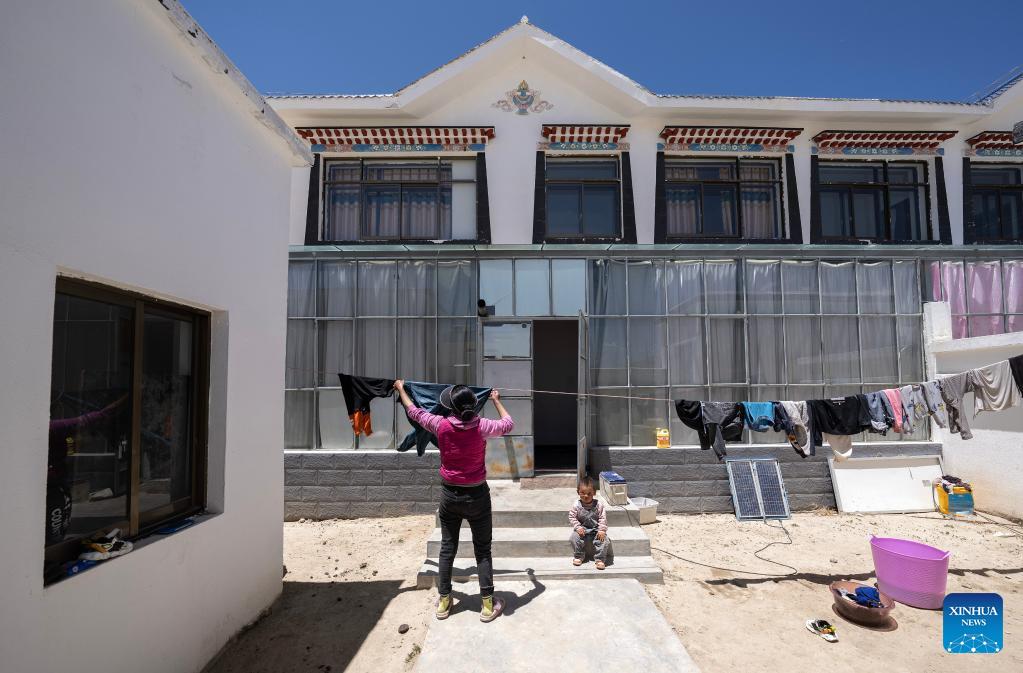
A grand daughter in law of Losang Zhamdu, airs her laundries at her "fifth-generation" house in Demqog Village, Zhaxigang Township, Gar County in Ngari Prefecture of southwest China's Tibet Autonomous Region, May 28, 2023. Sitting in the sun outside his residence in Demqog Village, Zhaxigang Township, Gar County in Ngari Prefecture of Tibet, 84-year-old Losang Zhamdu told a story of the five homes he had lived in.
"My mother and I lived together in a tent made with yak hair, all our possessions were a goat fur jacket and a worn-out Tibetan blanket," recalled Losang Zhamdu, then a serf, on his childhood, adding, "Was that tent my first home? I don't know, because everything in our hand belonged to the serf owners."
In 1959, democratic reform was launched and feudal serfdom was finally abolished in Tibet. A million serfs and slaves were emancipated, and 20-year-old Losang Zhamdu was one of them.
In the 1960s, with the help of his neighbors, Losang Zhamdu built his second home - a "two-bedroom" flat with stone and mud. Such houses are called "first-generation" ones in Demqog Village.
"This house is not very good. The roof leaked when it rained, and we even didn't have a stove for cooking. But it was much more comfortable if compared to our tent," Losang Zhamdu said of his second home.
In 1990, Demqog was officially established as an administrative village, which came along with "second-generation" houses built with adobe. Through the joint efforts of his family, neighbors and border guards, Losang Zhamdu was able to move in his third home.
In 2006, Losang Zhamdu celebrated the inauguration of his fourth home, also known as the "third-generation" house of Demqog Village - a house with bricks and concrete structure. "It's a comfortable house. I like it very much." Losang Zhamdu said the local government also helped to drill a well next to his home.
In 2010, Shaanxi Province, which had been assisting Ngari, shifted its aids to the construction of new rural areas, and Gar County also kicked off a series projects in Demqog. The village has launched a solar power station for regular electricity service, a village square, a fitness area, a reading room and other supporting facilities. A paved road was also built to connect the outer world.
In 2012, Demqog Village ushered in its fourth-generation houses, two-story buildings of reinforced concrete structure that come with courtyards.
In September 2019, a group of Demqog villagers including the Losang Zhamdu family held a move-in ceremony for their "fifth-generation" houses - two-story, fully functioning buildings each covering a construction area of more than 200 square meters with an exclusive courtyard.
Before the peaceful liberation of Tibet, more than 90 percent of the people had no home of their own, and many serfs even had to live in sheds for livestock, with little clothing and food. By 2020, the per capita housing space of farmers and herdsmen in Tibet had reached 41.46 square meters. (Xinhua/Fei Maohua)
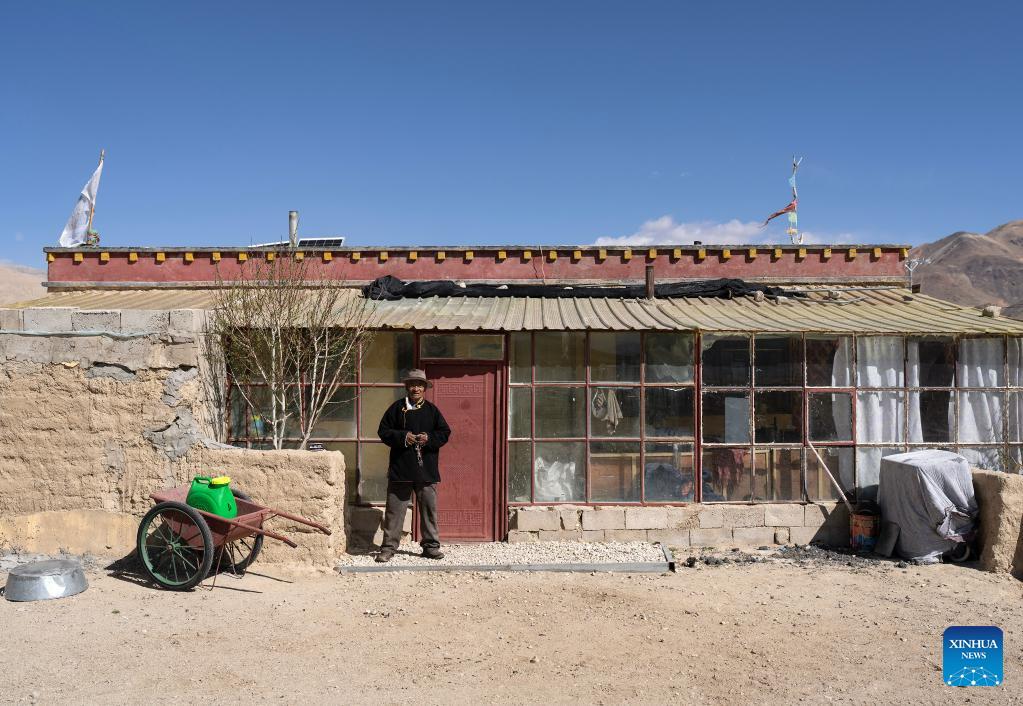
Losang Zhamdu poses for photos in front of his fourth residence, or one of the "third-generation" houses, in Demqog Village, Zhaxigang Township, Gar County in Ngari Prefecture of southwest China's Tibet Autonomous Region, May 28, 2023. Sitting in the sun outside his residence in Demqog Village, Zhaxigang Township, Gar County in Ngari Prefecture of Tibet, 84-year-old Losang Zhamdu told a story of the five homes he had lived in.
"My mother and I lived together in a tent made with yak hair, all our possessions were a goat fur jacket and a worn-out Tibetan blanket," recalled Losang Zhamdu, then a serf, on his childhood, adding, "Was that tent my first home? I don't know, because everything in our hand belonged to the serf owners."
In 1959, democratic reform was launched and feudal serfdom was finally abolished in Tibet. A million serfs and slaves were emancipated, and 20-year-old Losang Zhamdu was one of them.
In the 1960s, with the help of his neighbors, Losang Zhamdu built his second home - a "two-bedroom" flat with stone and mud. Such houses are called "first-generation" ones in Demqog Village.
"This house is not very good. The roof leaked when it rained, and we even didn't have a stove for cooking. But it was much more comfortable if compared to our tent," Losang Zhamdu said of his second home.
In 1990, Demqog was officially established as an administrative village, which came along with "second-generation" houses built with adobe. Through the joint efforts of his family, neighbors and border guards, Losang Zhamdu was able to move in his third home.
In 2006, Losang Zhamdu celebrated the inauguration of his fourth home, also known as the "third-generation" house of Demqog Village - a house with bricks and concrete structure. "It's a comfortable house. I like it very much." Losang Zhamdu said the local government also helped to drill a well next to his home.
In 2010, Shaanxi Province, which had been assisting Ngari, shifted its aids to the construction of new rural areas, and Gar County also kicked off a series projects in Demqog. The village has launched a solar power station for regular electricity service, a village square, a fitness area, a reading room and other supporting facilities. A paved road was also built to connect the outer world.
In 2012, Demqog Village ushered in its fourth-generation houses, two-story buildings of reinforced concrete structure that come with courtyards.
In September 2019, a group of Demqog villagers including the Losang Zhamdu family held a move-in ceremony for their "fifth-generation" houses - two-story, fully functioning buildings each covering a construction area of more than 200 square meters with an exclusive courtyard.
Before the peaceful liberation of Tibet, more than 90 percent of the people had no home of their own, and many serfs even had to live in sheds for livestock, with little clothing and food. By 2020, the per capita housing space of farmers and herdsmen in Tibet had reached 41.46 square meters. (Xinhua/Fei Maohua)
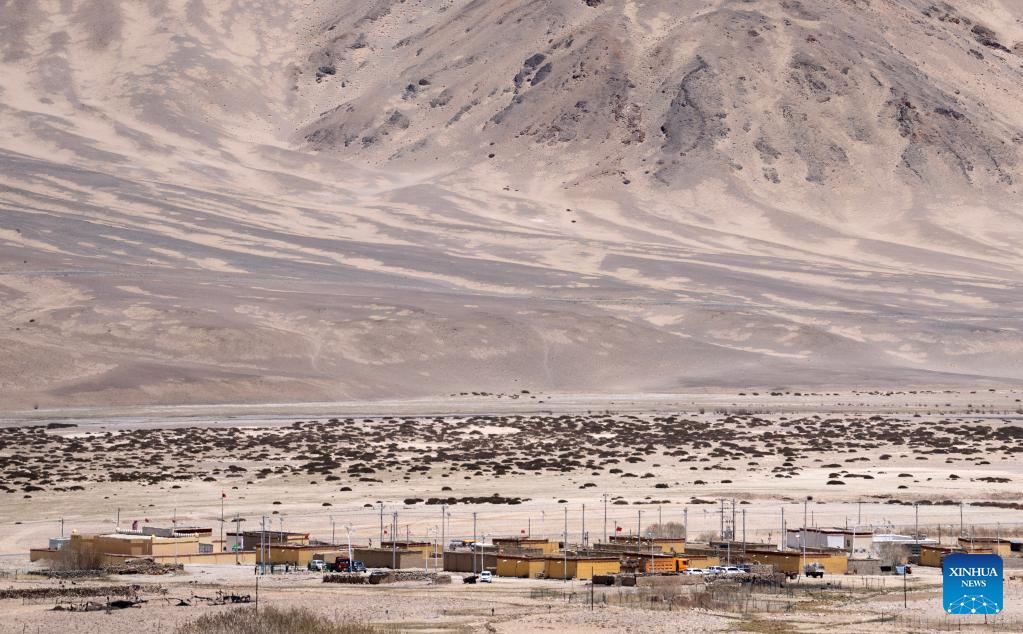
This photo taken on May 28, 2023 shows a view of the "third-generation" houses in Demqog Village, Zhaxigang Township, Gar County in Ngari Prefecture of southwest China's Tibet Autonomous Region. Sitting in the sun outside his residence in Demqog Village, Zhaxigang Township, Gar County in Ngari Prefecture of Tibet, 84-year-old Losang Zhamdu told a story of the five homes he had lived in.
"My mother and I lived together in a tent made with yak hair, all our possessions were a goat fur jacket and a worn-out Tibetan blanket," recalled Losang Zhamdu, then a serf, on his childhood, adding, "Was that tent my first home? I don't know, because everything in our hand belonged to the serf owners."
In 1959, democratic reform was launched and feudal serfdom was finally abolished in Tibet. A million serfs and slaves were emancipated, and 20-year-old Losang Zhamdu was one of them.
In the 1960s, with the help of his neighbors, Losang Zhamdu built his second home - a "two-bedroom" flat with stone and mud. Such houses are called "first-generation" ones in Demqog Village.
"This house is not very good. The roof leaked when it rained, and we even didn't have a stove for cooking. But it was much more comfortable if compared to our tent," Losang Zhamdu said of his second home.
In 1990, Demqog was officially established as an administrative village, which came along with "second-generation" houses built with adobe. Through the joint efforts of his family, neighbors and border guards, Losang Zhamdu was able to move in his third home.
In 2006, Losang Zhamdu celebrated the inauguration of his fourth home, also known as the "third-generation" house of Demqog Village - a house with bricks and concrete structure. "It's a comfortable house. I like it very much." Losang Zhamdu said the local government also helped to drill a well next to his home.
In 2010, Shaanxi Province, which had been assisting Ngari, shifted its aids to the construction of new rural areas, and Gar County also kicked off a series projects in Demqog. The village has launched a solar power station for regular electricity service, a village square, a fitness area, a reading room and other supporting facilities. A paved road was also built to connect the outer world.
In 2012, Demqog Village ushered in its fourth-generation houses, two-story buildings of reinforced concrete structure that come with courtyards.
In September 2019, a group of Demqog villagers including the Losang Zhamdu family held a move-in ceremony for their "fifth-generation" houses - two-story, fully functioning buildings each covering a construction area of more than 200 square meters with an exclusive courtyard.
Before the peaceful liberation of Tibet, more than 90 percent of the people had no home of their own, and many serfs even had to live in sheds for livestock, with little clothing and food. By 2020, the per capita housing space of farmers and herdsmen in Tibet had reached 41.46 square meters.
